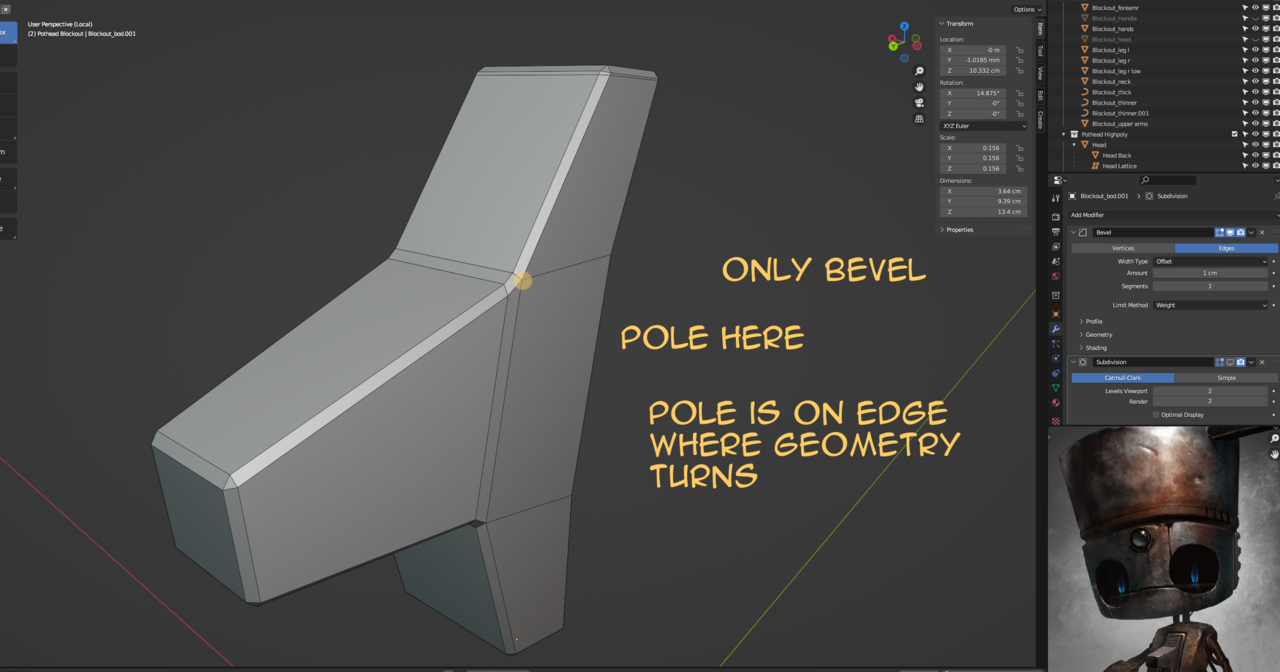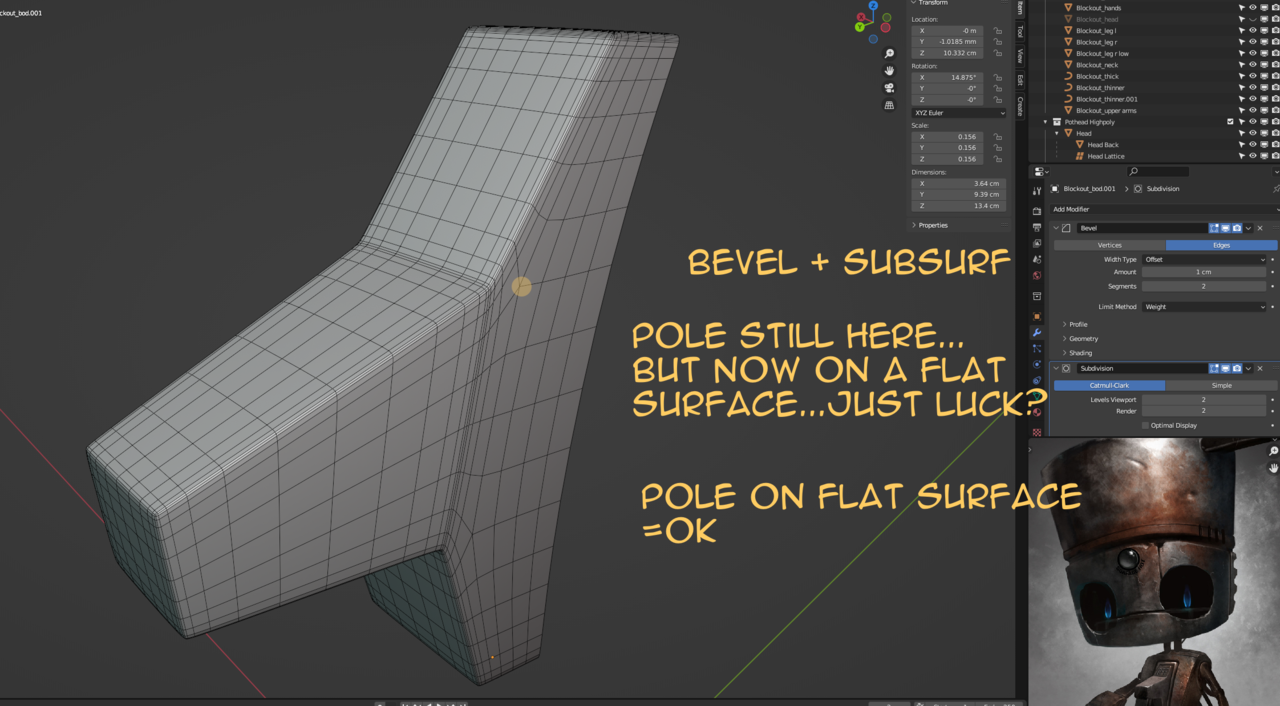SubSurf works as long as it's quads. There are different kinds of poles in quad topology. Nose Pole or N-Pole for short is 3 edges connected to a vertex. This is common when modeling a characters nose. Thus why it's called a nose pole. In your case it's an Extrude Pole or E-Pole for short. These are common when you extrude. They also control the flow of face loops. In this case(Second image) you have 2 triangles that are small and thus stops the pinching caused from the SubSurf modifier. Since they are small The affect on the shading is very small. I hope that makes sense. Also there is the 6+ Pole with is as you guessed is 6 or more edges. you can see this in the top and bottom of the UV Sphere. This is also called a Fan topology.
Hi Dwayne,
first, thanks for the swift reply! I looked it up, Vertices connected to 5 Edges is called E-Pole, that must be what you meant...
I don´t think I have 2 small triangles in my second image, but indeed, the shading issues regarding Poles + Subsurf gets less noticeable when the faces are smaller (from what I saw so far)
You said at the very beginning that Subsurf works as long as it is all quads, are Poles not bad for Subsurf then ? Since even after the bevel, the Pole still persists, but the shading issue on the Subsurf is gone (Image attached)
Tbh, I still don`t understand why Poles/Ngons are bad for Subsurf, i mean yes, the topology gets pulled/pinched, but WHY is it getting pulled/pinched?
(I´d like to read/watch more about these topology dos and don´ts, preferably with indepth explanation, if you could point me to some in depth material (paid or free), I´d be very thankful !


Hi Nougat,
The whole issue of Poles, has to do with the effect of unevenly sized Faces on the shading of a Mesh and on its deformations.
If you have two Edges close next to each other, the Subdividing the Mesh, will give a high density of Edges in that area. (I think that one is obvious. Look at your last screenshot, for instance).
With Poles, sort of the opposite happens. To understand this, you need to know, that the Subdivision Surface algorithms use the center of Faces and connect them to the (center of the) Faces' Edges.
The more Edges are connected to a Pole, the smaller the angle between two adjacent Edges, and the center of the Face gets 'pushed' away from the pole, so the density of the Mesh around a Pole, when Subdividing is less, than further away from the Pole:

See how the centers get 'squeezed' outward, away from the Pole. This, together with the fact that the 'pizza slices' also get more 'stretched', when the number of connected Edges of a Pole increases, can cause serious Shading issues and uneven deformations.
If there are not going to be any deformations, Poles and N-Gons are usually no problem if they are on flat surfaces.
I hope this helps a bit.
I don't know how technical you want to get, Martin and Dwayne are super knowledgeable, but my thinking for my dumb brain is, usually going too deep doesn't really matter, there's always limitations in systems, you can ask "why" to every answer over and over until infinity. So I guess my advice would be, meh, don't worry about it, Subdiv only works good with quads, it is how it is, I'm usually like ok cool that's how it goes, there's this and that other rule? Ok got it, and move on.
In the end, for me, I'm pursuing a cool art piece, a great render, as if building a house, I want my result to be the coolest house on the block, if I stop too long on why the hammer hammers nails down but why does it not work good enough with that nail and not with this nail, I'm never going to finish my house. So I'm like ok cool I just wont use this nail, it just doesn't work with that other nail, so be it, lets get hammering.
Again, I'm not saying is wrong trying to investigate what's up with each nail, it'll depend if you're interested in the technical aspects, but if your main goal is to build the house, don't think about it too much, go with the flow. And again, also not wrong wanting both, to know the technical and build the house, just saying that it is also ok to work with what you got and not feel like you are going to get stuck or be less productive if you don't know all the nitty gritty.
MMartin I think that helps, I think now I understand that the pull comes from uneven texel density, that result from faces being too "sharp" on one corner, which tend to happen when a pole connected to the face has more than 4 edges connected to them.
And Quads generally don´t have this issue cuz there are usually always 4 edges connected (that´s not always right but oh well)
And the shading issues caused by Poles are less severe when the geometry is smaller, even on turning points
oomar I think I´m obsessed with finding out why, cuz good topology goes a long way, and there just aren´t enough clear answers on what really is causing which issue and why. I mean take this Subsurf shading issue as an example, some say Ngons are the issue, then Creative Shrimp (ditched that course for now cuz too advanced) says Ngons are fine, Poles are the issue, and later down the course I see the shading gets fixed while there´s still a pole sitting right on the edge where the corner turns, It´s really confusing when you touch the issue for the first time(or after several times, if you just aren´t sure what´s causing the issue.
So i wanna build the house but I also really want to know why there´s a shading issue on the house, cuz if Ngons are fine, Poles are ok sometimes, then clearly I don´t know what´s causing what
Hi Nougat Time,
One thing you should know, is that a watertight Mesh always has Poles (the Default Cube, for instance, consists of only Poles). So don't try to avoid Poles no matter what; that is mathematically impossible.
Do try to avoid 6-sided Poles (and higher). (Although they won't be much of a problem of flat surfaces, but avoid them close to the edges of said flat surface.)
And finally, here is a great article for you to read (maybe bookmark it and save for later, or just for reference):
https://graphics.pixar.com/opensubdiv/docs/subdivision_surfaces.html
Definitely not something you need to know, but I think you might find it interesting.
Realistically everything topology-wise should be fine, as long as it doesn't bother anyone. You can have poles, Ngons, triangles, in a place where it doesn't cause a mess. And lots of times you can have them in places that do cause a mess but you hide it pretty well. In the end, it's all about the end outcome, if you're going to present a good model and people are going to inspect it expecting it to be a god model, then you can't get away with anything. But if it's only just the outcome, what's going to be on screen at render time, so much easier to get away with stuff. But I know, what you're after is knowledge, trying to understand how this geometry behaves, it's quirky to say the least.
Thank you everyone, you have been most helpful! That´s what I love about being here!
I´m defintely going to check that article out, looks like a great source for knowledge~